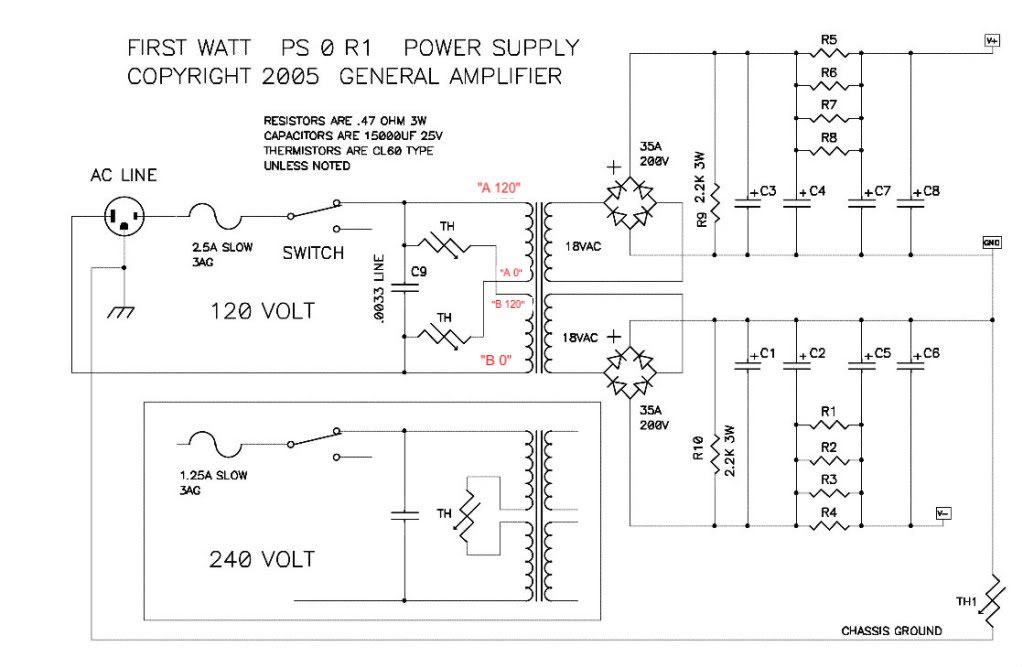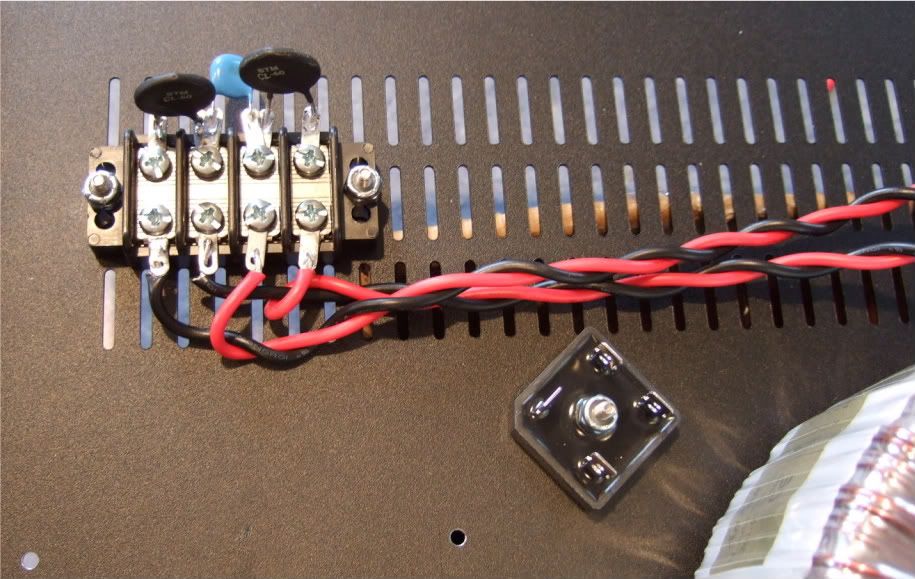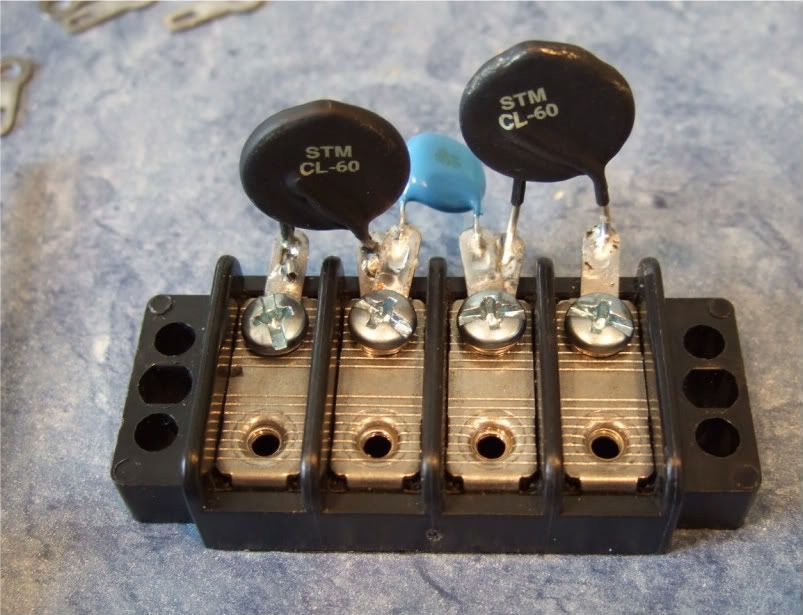Hi CanAm Man
Zen Mod is quite right they will be cooler on the F5 maybe if the current is low enough and you are running the stock one.
Best thing is to have a look at the data sheet.
Ops Just did and I need to read the lot better there is no Graph that jumps out and bite me in the but.
Was wrong about the 150 C data sheet mention 175 operating temperature actually.
So got a few options
Forget about it.
Wait for some one to stick a thermometer on it.
Wait for the usual expert to dole out the info.
Be aware on how they work and cheek it out.
All I know is as follows
They work by getting hot and the heath causes the resistance to drop
At a certain point they reach equilibrium as with the resistance getting lower the power they dissipate get smaller the temperature at which they settles depends on how much current you pull.
(I think but then I may be wrong).
Better safe than sorry.... so sorry for the distress I caused you are insured any way?
Zen Mod is quite right they will be cooler on the F5 maybe if the current is low enough and you are running the stock one.
Best thing is to have a look at the data sheet.
Ops Just did and I need to read the lot better there is no Graph that jumps out and bite me in the but.
Was wrong about the 150 C data sheet mention 175 operating temperature actually.
So got a few options
Forget about it.
Wait for some one to stick a thermometer on it.
Wait for the usual expert to dole out the info.
Be aware on how they work and cheek it out.
All I know is as follows
They work by getting hot and the heath causes the resistance to drop
At a certain point they reach equilibrium as with the resistance getting lower the power they dissipate get smaller the temperature at which they settles depends on how much current you pull.
(I think but then I may be wrong).
Better safe than sorry.... so sorry for the distress I caused you are insured any way?
I've read comments about using thermal grease to mount the full-wave bridge rectifiers to the amp chassis/bottom plate.
Is it essential? optional? unncecssary?
Standing by, with my Arctic Silver, if you think I need to do so......
Thanks
it will no do any harm , and certainly will make bosses of Arctic SIlver Co. richer ( and life of their divorced wifes much easier )
in any case - that's almost sole place where in amp you can really use that drek ; Arctic Silver is electrically conductive .... in amps good just for completely insulated parts .
A ClassA amp draws continuous high levels of current through the rectifier.
As a result a ClassA rectifier runs much hotter than a ClassAB rectifier.
Additional heat put into the bottom plate will increase the internal ambient temperature.
yup ;
so best to mount them outdoor .
garden is certainly enough displaced from amp enclosure

Arctic Silver 5--conductive??
ZM, and All--I hope that's not right, about Arctic Silver....since I DID use it on my MOSFETS and heatsinks
Arctic Silver is electrically conductive .... in amps good just for completely insulated parts.
ZM, and All--I hope that's not right, about Arctic Silver....since I DID use it on my MOSFETS and heatsinks

AS5 is not conductive, but it is capacitive. The Arctic Silver line of products are also mean for minimum bond line application, in other words the part it is on is supposed to come into direct contact with the heatsinking surface anyways.
The stuff is expensive, but from using it for computer heatsinks it can shave a couple degrees off the operating temps versus run of the mill thermal pastes.
The stuff is expensive, but from using it for computer heatsinks it can shave a couple degrees off the operating temps versus run of the mill thermal pastes.
Arctic Silver 5--more info
This from the company website, specifically related to Arctic Silver 5:
"Not Electrically Conductive. Arctic Silver 5 was formulated to conduct heat, not electricity. (While much safer than electrically conductive silver and copper greases, Arctic Silver 5 should be kept away from electrical traces, pins, and leads. While it is not electrically conductive, the compound is very slightly capacitive and could potentially cause problems if it bridges two close-proximity electrical paths.)
--end of company website quote--
I also laid a bead on a piece of glass, and tested with my digital VOM. No indication of conduction--infinite resistance reading.... I feel a lot better now. Blood pressure has returned to normal
This from the company website, specifically related to Arctic Silver 5:
"Not Electrically Conductive. Arctic Silver 5 was formulated to conduct heat, not electricity. (While much safer than electrically conductive silver and copper greases, Arctic Silver 5 should be kept away from electrical traces, pins, and leads. While it is not electrically conductive, the compound is very slightly capacitive and could potentially cause problems if it bridges two close-proximity electrical paths.)
--end of company website quote--
I also laid a bead on a piece of glass, and tested with my digital VOM. No indication of conduction--infinite resistance reading.... I feel a lot better now. Blood pressure has returned to normal

Cryptic as in most of your post not the last one necessarily.
Actually now that I read it properly that post had same good stuff in it.
Quote >Active silver is electrically conductive.
There is same "new" stuff made with graphite that is even better.
10.5W/mK if this make any sense (hardly any to me but is expensive so it must be good)
Still conductive so again like Artic silver best place for it be on the CPU.
Cryptic as when you throw at as beginner’s papers to read with stuff like the square root of -1.
I see reed every time can't help.
Done my Laplace transform far to long ago
Or like
Quote> they're cool enough
but you don't want to touch them while power is on
Wonder the impact it would have.
To just say on the one I allegedly never built they were running at X C with Y current and Z voltage.
Still don’t get me wrong I rely appreciate any stuff you throw at (with licence) Us.
And I really mean this.
Maybe I have a beef with some one else?
So to be honest I was the one being cryptic this time maybe.
Suppose we will find out tomorrow morning UK and near about places time.
So tanks Zen for al your Cryptic and not post and for the Dumb ones as well at least I know that is not (Sorry cant say or get binned).
Actually some stuff came to mind.
 If it came from Zen it must be fertilizer not immediately evident but it will make things grow and prosper.
If it came from Zen it must be fertilizer not immediately evident but it will make things grow and prosper.
Actually now that I read it properly that post had same good stuff in it.
Quote >Active silver is electrically conductive.
There is same "new" stuff made with graphite that is even better.
10.5W/mK if this make any sense (hardly any to me but is expensive so it must be good)
Still conductive so again like Artic silver best place for it be on the CPU.
Cryptic as when you throw at as beginner’s papers to read with stuff like the square root of -1.

I see reed every time can't help.
Done my Laplace transform far to long ago
Or like
Quote> they're cool enough
but you don't want to touch them while power is on
Wonder the impact it would have.
To just say on the one I allegedly never built they were running at X C with Y current and Z voltage.
Still don’t get me wrong I rely appreciate any stuff you throw at (with licence) Us.
And I really mean this.
Maybe I have a beef with some one else?
So to be honest I was the one being cryptic this time maybe.
Suppose we will find out tomorrow morning UK and near about places time.
So tanks Zen for al your Cryptic and not post and for the Dumb ones as well at least I know that is not (Sorry cant say or get binned).
Actually some stuff came to mind.
Right
Artic Silver 5 now you mention it.
One of the products that company makes now
After the uge success they had with the original stuff made for CPU that made them famous and was conductive
Pondering about things..
Maybe same of the "Expert" and in this case the real expert dole out information as there are so many variables and different circumstancess so that they can only dole out the information as if misinterpreted or used incorectley the information they dole out may cause people like me to do silly or dangerous things.
In this case the missing number 5 moved the goal post
Frustrating?
yes
But what about the other kind of Experts
The one that post junk all the time or the ones that just wait for someone to say someting wrong.
More frustrating
YES YES
So tanks Zen
Artic Silver 5 now you mention it.
One of the products that company makes now
After the uge success they had with the original stuff made for CPU that made them famous and was conductive
Pondering about things..
Maybe same of the "Expert" and in this case the real expert dole out information as there are so many variables and different circumstancess so that they can only dole out the information as if misinterpreted or used incorectley the information they dole out may cause people like me to do silly or dangerous things.
In this case the missing number 5 moved the goal post
Frustrating?
yes
But what about the other kind of Experts
The one that post junk all the time or the ones that just wait for someone to say someting wrong.
More frustrating
YES YES
So tanks Zen
There are 2 voices to listen to one is the voice of reason the other is the reasonable voice, both are correct as are nearly all points in between.
try both and report back ...
The voice in your head says if some is good, more is better, then too much is just enough, Elwood
try both and report back ...
The voice in your head says if some is good, more is better, then too much is just enough, Elwood
.....
I have no idea what I am doing though.
then stop !
please - upload schematic of that what you are trying to make .
Ok, let's look at the schematic. Remember that I am wiring it for 120v operation, so the transformer primaries are in parallel. People wiring for 240 with a transformer like this, please ignore.

Notes in red are mine.
Look at the connections of the transformer primary, through the thermistors and line cap, to the mains.
Hot AC is connected to the "120" (which in my case is the red leads on the primaries) One red primary is connected to AC hot through a thermistor.
Neutral AC is connected to the black "0" leads, one of which is connected to the AC through a thermistor.
AC Hot and Neutral have a cap across the leads.
So, yes, the AC will be connected to the center 2 posts, which is across the cap.

Left to right we have post 1, 2, 3, 4
POST 1 - Transformer primary 'B 0' which will be connected to AC Neutral at post 2, through the thermistor between post 1 and 2.
POST 2 - AC Neutral in (not shown in photo), connected to Transformer primary 'A 0" , a thermistor to post 1, and a line cap to post 3
POST 3 - AC Hot in, connected to transformer primary "B 120", thermistor to post 4, and line cap to post 2
POST 4 - Transformer primary "A 120", connected to AC Hot through the thermistor to post 3
If you look at the red and black wires in the photo you will see that the Mains AC must to pass through a thermistor to connect to each of the 2 primaries. And that is the point of them, to keep inrush under control during powerup.
If I am doing something wrong, somebody please tell me!

Notes in red are mine.
Look at the connections of the transformer primary, through the thermistors and line cap, to the mains.
Hot AC is connected to the "120" (which in my case is the red leads on the primaries) One red primary is connected to AC hot through a thermistor.
Neutral AC is connected to the black "0" leads, one of which is connected to the AC through a thermistor.
AC Hot and Neutral have a cap across the leads.
So, yes, the AC will be connected to the center 2 posts, which is across the cap.

Left to right we have post 1, 2, 3, 4
POST 1 - Transformer primary 'B 0' which will be connected to AC Neutral at post 2, through the thermistor between post 1 and 2.
POST 2 - AC Neutral in (not shown in photo), connected to Transformer primary 'A 0" , a thermistor to post 1, and a line cap to post 3
POST 3 - AC Hot in, connected to transformer primary "B 120", thermistor to post 4, and line cap to post 2
POST 4 - Transformer primary "A 120", connected to AC Hot through the thermistor to post 3
If you look at the red and black wires in the photo you will see that the Mains AC must to pass through a thermistor to connect to each of the 2 primaries. And that is the point of them, to keep inrush under control during powerup.
If I am doing something wrong, somebody please tell me!
Last edited:
6L6,
that mains connection layout works.
Mains Live and Neutral feed into posts 3 and 2 respectively.
Each primary has it's own series connected CL60.
The two primaries are in parallel.
There are no additional connections to posts 1 & 4.
The Live feed to post 3 needs an upstream fuse as well as the ON/OFF switch.
The Neutral feed from post 2 should have no fuse and may have a switch depending on local regulations.
that mains connection layout works.
Mains Live and Neutral feed into posts 3 and 2 respectively.
Each primary has it's own series connected CL60.
The two primaries are in parallel.
There are no additional connections to posts 1 & 4.
The Live feed to post 3 needs an upstream fuse as well as the ON/OFF switch.
The Neutral feed from post 2 should have no fuse and may have a switch depending on local regulations.
Ok, let's look at the schematic.
....... If I am doing something wrong, somebody please tell me!
6L6 (aka Jim). Your POSTS 1-4 correlate to my POSTS 2-5 on my terminal strip (numbering from left to right). We have both wired alike, for 120 VAC. You're good to go!
(Note that MY POSTS 1-2 are connected together, on the "low" line side, and that MY POSTS 5-6 go to the contacts on my bi-stable latching relay (read, on-off switch contacts) and the "high" line side fuse).
My 120 VAC chassis ground is the white lead, connecting to the large machine screw retaining one of the four chassis feet.
A pic of mine is attached, FYI....
Ken
- Home
- Amplifiers
- Pass Labs
- How to build the F5

 While typing my previous ranting
While typing my previous ranting 
